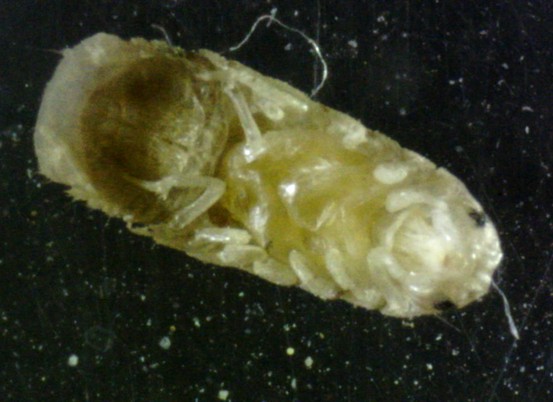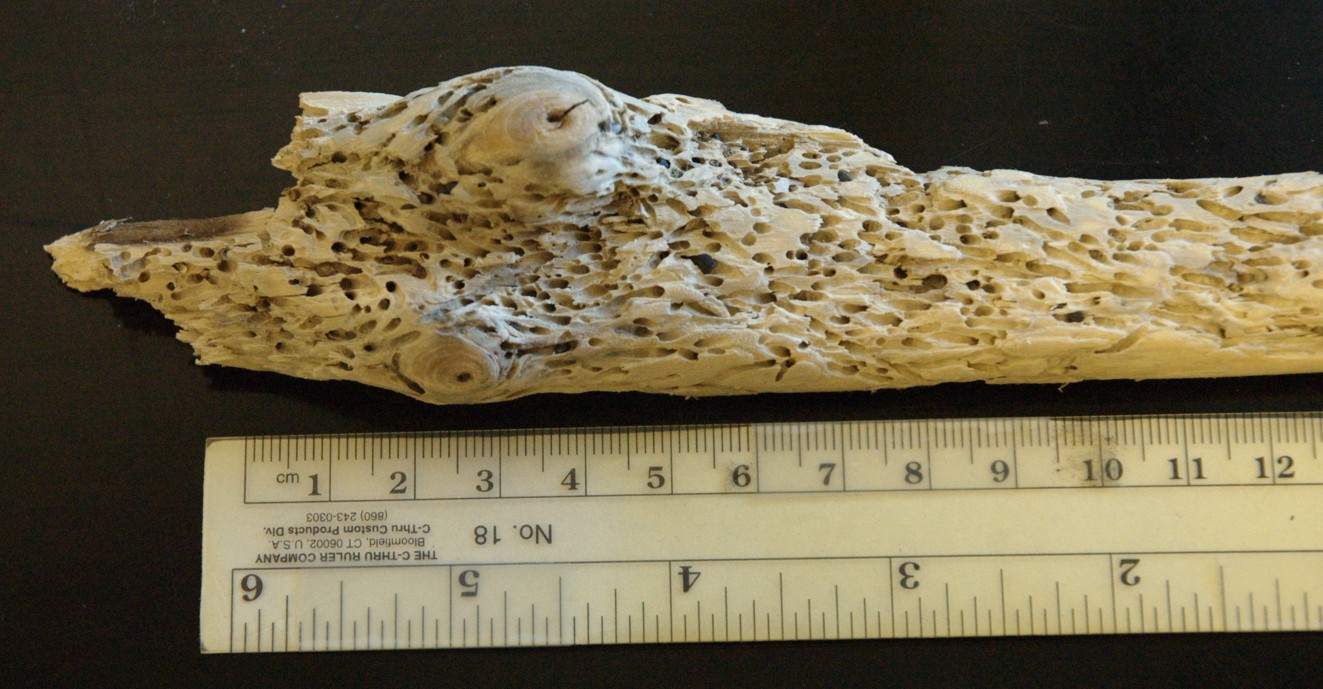Limnoria lignorum Rathke, 1799Common name(s): Gribble |
|
| Synonyms: |  |
|
Phylum Arthropoda
Class Malacostraca
Subclass Eumalacostraca
Superorder Peracarida
Family Limnoriidae
|
|
| Limnoria lignorum, about 3 mm long on the left and 2.5 mm long on the right, found boring into wood on Rialto Beach. These specimens are dried ones found within the cast-up driftwood. Several lighter particles or pustules are clinging to the dorsal pleotelson of the individual on the left--a phenomenon seen on several individuals. | |
| (Photo by: Dave Cowles) | |
Description: As in other Flabelliferan isopods, the uropods are flattened and are lateral to the pleotelson rather than ventral or terminal. The exopodites of the uropods do not arch over the pleotelson and pereopod 1 is not greatly enlarged. This family is unusual for an isopod because the head (cephalon) is not attached broadly to the pereon so the head can rotate, and the uropods are unusually small. The first thoracic (pereon) segment in Limnoria is about twice as long as the rest. In this species the pleon has 4-5 visible pleonites plus the pleotelson. The animal can roll up into a ball. The uropods are small, and the exopodites of the uropods are somewhat clawlike. The incisor process of the right mandible has file-like ridges, and the incisor process of the left mandible has rasplike scales (but the mandibles have no teeth). The dorsal surface of the pleotelson has a small median ridge that splits into two ridges posteriorly but does not have 3 or 4 small tubercles. Bores into wood. Usually less than 4 mm long.
How to Distinguish from Similar Species:Limnoria algarum bores into kelp holdfasts. Limnoria tripunctata bores into wood but it has 3 small tubercles on the dorsal pleotelson instead of the bifurcating ridge.
Geographical Range: In temperate and polar waters of the northern hemisphere. From Kodiak Alaska to Point Arena, California on our coast.
Depth Range: Intertidal to 20 m
Habitat: Boring into wood
Biology/Natural History:
This species
bores into wood near the intertidal zone, such as pilings and
driftwood.
Its boring rate is about 1-3 cm/year, and it can eventually do
extensive
damage. The burrows of this isopod are far smaller in
diameter than
that of the shipworms (bivalves which also bore into wood), being only
about 1 mm in diameter (photo).
When
digging, they jerk their head back and forward while turning slowly in
the burrow. They typically start to burrow into the wood at a
shallow
angle rather than digging straight in. They swallow the wood
chips,
which pass through the gut as rapidly as 80 minutes. Besides
being
of much smaller diameter, the burrows of gribbles are much shallower
than
those of shipworms, going only a centimeter or two into the
wood.
Also, unlike shipworms, they often dig interconnections between their
burrows
(photo).
Although this species has several
ciliated protozoan symbionts, some of which also produce cellulases, it
is a very unusual animal because it appears to produce the cellulase
enzymes
necessary for digesting the cellulose in the wood itself. The
gut,
where the wood is digested, appears to be sterile, with very few or no
bacteria or protozoans within it. One further problem with
digesting
cellulose from wood is that much of the cellulose is bound in lignin,
which
is very difficult to digest. A related species (L.
quadripunctata, see King et al., 2010) has high amounts of
hemocyanin
in its gut which may produce phenoloxidase. The phenoloxidase
may
be used to break up lignin, plus may explain why bacteria seem absent
from
the gut since phenoloxidase is toxic to bacteria. Various
symbionts
can be found on the outer surface, especially the pleopods, and may be
important in providing nitrogen to the animal.
Females of this species carry around 22 large eggs in their marsupium
or pouch between the front legs. The eggs are nearly 1/4 the
width
of the body. They do not hatch into a larval stage
but instead
hatch like small adults which begin burrowing. Therefore
gribble
colonies in wood are quite localized and spread slowly across the wood
surface as they reproduce and start more burrows. Young and
eggs
can be found year-round, but peak breeding in the Salish Sea area is in
April and May. Not only do the young not normally swim, but
they
do not even seem to be chemically attracted to wood, as many other
larvae
are attracted to their appropriate substrates when settling.
Presumably
they simply remain on the wood in which they are born and begin
burrowing
there by default. Later in life, some adults do swim away,
especially
in the spring and summer. During this migration phase they do
respond
positively to wood (see references in Cragg
et al., 1999). Their preference for wood seems to
be enhanced
by the presence of fungus or fungal metabolites on the surface or the
scent
of other gribbles.
| Return to: | |||
| Main Page | Alphabetic Index | Systematic Index | Glossary |
References:
Dichotomous Keys:Carlton, 2007
Flora and Fairbanks, 1966
Kozloff, 1987, 1996
General References:
Johnson and Snook, 1955
Kozloff, 1993
Ricketts et al., 1985
Scientific Articles:
Cragg,
S.M., A.J. Pitman, and S.M. Henderson, 1999.
Developments in
the understanding of the biology of marine wood boring crustaceans and
in methods of controlling them. International
Biodeterioration and
Biodegredation 43:4 pp 197-205
Elshanshoury, A.R., M.H. Mona, F.A. Shoukr, and A.M. Elbossery, 1994. The enumeration and characterization of bacteria and fungi associated with marine wood boring isopods, and the ability of these microorganisms to digest cellulose and wod. Marine Biology 119:3 pp 321-326
King, Andrew J., Simon M. Cragg, Yi Li, Jo Dymond, Matthew J. Guille, Dianna J. Bowles, Neil C. Bruce, Ian A. Graham, and Simon J. McQueen-Mason, 2010. Molecular insight into lignocellulose digestion by a marine isopod in the absence of gut microbes. Proceedings of the National Academy of Sciences 107:12 pp 5345-5350 (for a related species, L. quadripunctata)
Richards, B.R. and C.I. Belmore, 1976. Occurrence of
woodborer,
Limnoria-lignorum (Rathke) at Amchitka Island, Alaska.
Journal of
the Fisheries Research Board of Canada 33:7 pp 1642-1644
Web sites:
General Notes and Observations: Locations, abundances, unusual behaviors:
This is the piece of washed-up driftwood from which the Limnoria lignorum photographed above was extracted. The ruler is included for scale.

A ventral
view of another individual from the same piece of wood.
Authors and Editors of
Page:
Dave Cowles (2015): Created original page
CSS coding for page developed by Jonathan Cowles (2007)
Salish Sea Invertebrates web site provided courtesy of Walla
Walla University
